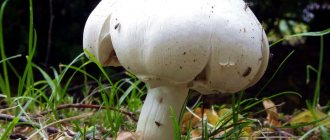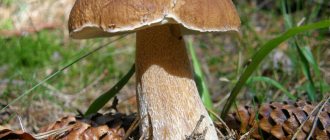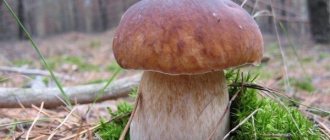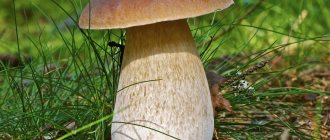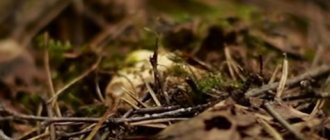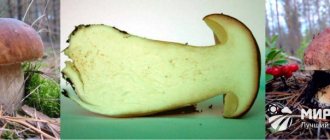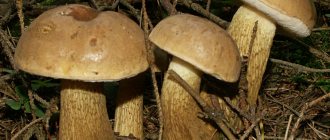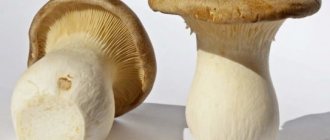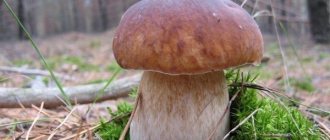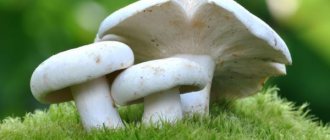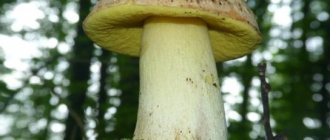Contrary to popular belief, it is indeed possible to confuse porcini mushrooms with their poisonous counterparts, despite the fact that boletus mushrooms differ significantly from other species. And although the white mushroom has only two doubles and they rarely lead to death, you still need to know how to distinguish the white mushroom from the false double.
In this article we will look at the characteristic features of real porcini mushrooms, and also consider its most common counterparts with external features and photos that will help to accurately determine edibility. Using our tips, you can avoid the danger of poisoning and do not put a poisonous mushroom in the basket.
Difficult relatives
White mushroom and its dangerous or inedible counterparts
Many well-known and popular mushrooms have close, but less edible, counterparts. Most often these are their own close relatives belonging to the same family of mushrooms.
The King of Mushrooms, Borovik, was also lucky with this, because in his family there are plenty of relatives similar to him, but not nearly as tasty and safe.
Fortunately, none of them are deadly poisonous, but there are some that are very inedible and can cause serious health problems.
Therefore, when going on a campaign for Porcini Mushrooms, it is always useful to familiarize yourself with the signs of their dangerous counterparts, so as not to mistakenly put them in the basket.
Each of these twin mushrooms has its own characteristic features by which they can be distinguished from Borovik, and the most important is the change in color of the flesh on the cut. In the White Mushroom it retains its snow-white color, which is how it got its name, but in its counterparts the flesh turns pink, turns blue, or otherwise changes its color.
Borovik's doubles
Below is a description of several varieties of dangerous relatives of the White Mushroom.
Harm and signs of poisoning
Mushroom picking is a fascinating, but extremely responsible activity. Poisonous false mushrooms, skillfully masquerading as edible ones, can play a cruel joke on an inexperienced mushroom picker, at best sending him to a hospital bed.
Even a small amount of the toxic substance that is found in dangerous boletus twins can cause a lot of problems. The first signs of poisoning appear a short time after consuming the product and include:
- nausea or vomiting;
- dizziness;
- general weakness;
- problems with stool;
- the appearance of hallucinations (not uncommon);
- disruption of the nervous system (convulsions);
- damage to the cardiovascular system.
Almost all of these processes are accompanied by an increase in temperature. If you notice at least one of the above symptoms, you should immediately seek medical help. While waiting for her, you need to start flushing your stomach yourself. However, this must be done carefully so that vomit does not enter the respiratory tract.
It is imperative to save those dishes that, in your opinion, caused the poisoning for further laboratory research and establishment of an accurate diagnosis.
Gall Mushroom Tylopilus Felleus
White mushroom and its dangerous or inedible counterparts
Mushroom from the genus Tilopil, family Boletaceae, also known as Gorchak and False White Mushroom.
Appearance
The cap is up to 10 cm in diameter, initially convex, as it ages it becomes flat-convex, dry and smooth. Painted in brownish-brown tones.
The hymenophore is tubular-type, the tubes are initially white, then dirty pink. Spore powder is pink.
The leg is up to 7 cm long and up to 3 cm in diameter, club-shaped, has a creamy-ocher color and is covered with a dark mesh pattern.
The pulp is thick and soft, white in color, turning pink when cut. It has no odor, but is extremely bitter in taste.
Where and when does it grow
Grows on sandy soils in coniferous forests from June to October. Doesn't happen very often.
Can it be eaten?
The gall mushroom is classified as inedible due to its extremely bitter taste. Moreover, after heat treatment, the bitterness only increases.
In addition, according to research, the pulp of this mushroom contains toxins that destroy liver cells, so eating gall mushroom in large quantities can cause cirrhosis.
However, the mushroom cannot be directly called poisonous. Some connoisseurs of mushroom cuisine soak it in salt water for a long time or dry it - after which the bitterness of the pulp disappears.
How to distinguish from Borovik
In the Gall Mushroom, the hymenophore is colored pink, but in young specimens it is white, which makes it easy to confuse it with Boletus. The second important feature is that the mesh pattern on the leg of Borovik is lighter than the main color of the leg, while that of the Gall Mushroom is darker.
How to process
Porcini mushroom is a perishable product and needs to be processed as quickly as possible after collection. According to expert advice, this time is 12 hours. You can slightly extend the shelf life of freshly picked mushrooms in the refrigerator.
Important! Already 12 hours after collection, up to 50% of the beneficial substances in the porcini mushroom are lost.
The beneficial properties of porcini mushroom include the fact that its pre-culinary processing is minimal: special cleaning, as well as preliminary soaking or boiling, is not required. However, if the mushrooms were collected incorrectly, then they need additional cleaning.
Important! Pre-treatment of porcini mushrooms intended for drying, freezing, and canning is somewhat different from the general scheme.
The general scheme of pre-culinary processing of porcini mushroom is as follows:
First stage
The mushrooms are sorted out and carefully examined, removing forest debris and discarding old and suspicious specimens. If most of the fruit body is affected by rot or worms, then it is definitely removed. If a small area is damaged, the mushroom is left for additional cleaning.
Second phase
The next stage is primary cleaning: first, the fruiting bodies are wiped with a soft brush or rag to remove forest litter and dirt adhering to them.
After this, strongly ingrained dirt is scraped off with a sharp knife - this is especially true if the mushrooms were collected after rain or in damp weather, and areas affected by pests are cut out. The lower part of the leg is also cut off.
Important! Even if the porcini mushroom was cut with a knife during collection, the cut is renewed when cleaning.
Third stage
Then the mushrooms are washed. To do this, first fill them with water and thoroughly wash each specimen separately, and then all together, changing the water several times.
Next, the porcini mushrooms need to be soaked in salted water. During this time, the debris and dirt stuck to the fruiting bodies become soaked, and various insects and pests that may have been hiding inside the pulp emerge. Soaking also helps remove sand. After this, the mushrooms are washed well again several times, changing the water each time.
Important! Maximum soaking time – 15 minutes. The pulp of the porcini mushroom tends to absorb water and, with longer soaking, becomes loose, watery and brittle, losing its taste and beneficial properties.
After washing, the mushrooms are placed in a colander and the water is allowed to drain.
Fourth stage
Next comes the final cleaning. After washing, all hidden, unnoticeable damage to the fruiting body caused by worms and other pests darkens. They are removed with a knife.
Advice! Usually the worms start eating the mushroom from the bottom of the stem. This part of the mushroom should be examined especially carefully.
Next, wipe the entire surface of the fruiting body with your hand. If the skin peels off in some place, this is an indicator of spoilage. This skin, as well as part of the pulp under it, is removed.
Advice! To identify hidden worms, it is recommended to cut the porcini mushroom lengthwise into two parts.
Fifth stage
And finally, the porcini mushrooms are washed under running water and placed in a colander to drain.
Advice! Mushrooms intended for cooking can be strained less thoroughly, as they will still be in the water. Porcini mushrooms that are going to be fried or stewed should be kept in a colander for more time.
Beautiful Boletus Caloboletus Calopus
Porcini mushroom and its dangerous or inedible counterparts
A mushroom from the genus Kalobolet, family Boletaceae, also known as Boletus Inedible.
Appearance
The cap is up to 15 cm in diameter, initially semicircular, then convex, with a wavy and tucked edge. Painted in light brown or brownish-gray shades.
The hymenophore is tubular-type, the tubes have small rounded pores and are colored in grayish or lemon-yellow shades. They turn blue when pressed. The spore powder is brownish-olive.
The leg is up to 15 cm high and up to 4 cm thick, cylindrical or club-shaped. It has several tiers of coloring - at the base of the leg it is white, then brown-red, in the central part it is carmine red, with a noticeable reddish mesh, in the upper part it is lemon yellow, with a fine white mesh.
The pulp is dense and hard, light cream in color, turning blue when cut in the cap and the upper part of the stem. It has no distinct odor and is very bitter in taste, and this bitterness does not immediately appear on the tongue.
Where and when does it grow
It bears fruit from July to October under spruce trees, in coniferous and mixed forests, most often under spruce trees.
Can it be eaten?
The mushroom is considered inedible due to its extremely bitter taste. If it accidentally gets into the pan along with ordinary boletus mushrooms, it will spoil the entire dish with bitterness. Data on the presence of toxins in this mushroom have not yet been precisely confirmed, but there is information about cases of severe poisoning due to accidental consumption of this mushroom.
How to distinguish from Borovik
This mushroom is easy to distinguish by the “multi-tiered” color of the stem and the red mesh on it.
Answers to common questions
Mushrooms are a rather heavy product, especially if it does not belong to the edible group. Bittersweet poisoning can even lead to cirrhosis of the liver. The insidiousness of the gall fungus is that the symptoms of poisoning may not appear immediately, but even after a month, when the use of mushrooms has already been forgotten, and some other reason for the malaise can be assumed.
Although the false boletus is not poisonous, it can quite seriously disrupt the functioning of the organs of an unwary gourmet. You need to be vigilant and attentive so as not to risk your health.
Rainy summer is the best time for mushroom pickers: numerous mushroom caps appear as if from nowhere. Mushroom picking is a useful activity that combines light physical activity and the interest of searching, and being in nature provides an opportunity to escape from the atmosphere of the city and feel one with nature. The process of preparing the harvest brings particular pleasure.
Unfortunately, inept mushroom picking can harm human health, since many mushrooms, after consumption, can not only cause stomach upsets and poisoning, but also death. Beginner mushroom pickers learn from more experienced ones, but even those are not immune from inattention when picking mushrooms. Therefore, mushroom pickers are recommended not only to take advice from more experienced comrades, but also to read encyclopedias.
Le-Gal's boletus Rubroboletus legaliae
White mushroom and its dangerous or inedible counterparts
A mushroom from the genus Rubroboletus, family Boletaceae, also known as the Legal Boletus.
Appearance
The hat is up to 15 cm in diameter, initially convex, and later hemispherical - spread out in shape. Painted in pink and orange shades.
The hymenophore is tubular-type, the tubes are colored red. Spore powder is olive-brown.
The leg is thick and swollen, up to 16 cm high and up to 5 cm thick, painted in shades of red, with a reddish mesh in the upper part.
The pulp is whitish or light in color and turns blue when cut. It has a mild taste and a pleasant mushroom smell.
Where and when does it grow
It grows from June to September, mainly in deciduous forests. Forms mycorrhiza with beech, hornbeam and oak, prefers alkaline soils.
Can it be eaten?
The mushroom is officially considered inedible and even poisonous, although there is no specific information about the toxins it contains.
How to distinguish from Borovik
This mushroom, as well as other false boletus mushrooms with a red color, can be easily distinguished by the color of the stem and the red mesh on it.
Speckled Oak Neoboletus Erythropus
Porcini mushroom and its dangerous or inedible counterparts
A mushroom from the genus Neoboletus, family Boletaceae, also known as Poddubnik and Boletus granulopod.
Appearance
The cap is up to 20 cm in diameter, hemispherical or cushion-shaped, matte and dry, initially velvety, later smooth. Its color varies from chestnut brown and red brown to black brown, with a lighter edge. Darkens when pressed.
The hymenophore is tubular-type, the tubes initially have a yellow-olive color, and subsequently become orange-red. They turn blue when pressed.
The leg is up to 10 cm long and up to 3 cm in diameter, tuberous in shape, may have a cavity inside, is colored in reddish-yellow shades and covered with dark red scales.
The flesh is fleshy and bright yellow, with a reddish tint in the stem. Turns blue when cut.
Where and when does it grow
Grows in August and September in deciduous and coniferous forests.
Can it be eaten?
Can. Unlike the other species presented here, this mushroom is classified as conditionally edible. It is quite edible after 20 minutes of preliminary boiling. Among collectors, this mushroom has its fans.
How to distinguish from boletus?
This species is easy to distinguish from the usual boletus by the color of the leg and the red scales on it.
Satanic Mushroom Boletus Satanas
Porcini mushroom and its dangerous or inedible counterparts
A mushroom from the genus Boletaceae, family Boletaceae.
Appearance
The cap is up to 25-30 cm in diameter, hemispherical or rounded-pillow-shaped, smooth, dry or slightly velvety to the touch. The basic color of the cap is dirty gray, but it is prone to considerable variability - it can have various whitish-gray, yellowish or ocher shades, be olive-gray, have yellow-pink or greenish stains.
Tubular-type hymenophores - tubes are greenish-yellow in color, the pores in them are small, initially yellow, and with age they acquire orange-brown-red shades. They turn blue when pressed.
Spore powder is brown-olive.
The leg is up to 10 cm wide and up to 15 cm high. Initially spherical or ovoid in shape, then it becomes tuberous or barrel-shaped, with a narrowing in the upper part. In the central part the leg has a blood-red or orange-red color, in the upper part it is yellowish-red, and at the very base it has a brownish-yellow tint. The leg is covered with a peculiar mesh pattern with round-shaped cells, usually dark red, but sometimes olive or white.
The flesh is white or slightly yellowish in the cap, in the stem with a reddish tint. It turns red or blue when cut. In young fruiting bodies, the pulp has a faint spicy odor, but in old ones it smells very unpleasant - like rotten onions. The flesh tastes bitter.
Where and When It Grows
It grows from June to September in light deciduous forests, most often on calcareous soils. It forms mycorrhiza with linden, hornbeam, beech, oak, hazel and edible chestnut. In our country, its main distribution area is the Krasnodar Territory and the republics of the North Caucasus, but in the central part of the country it is difficult to detect.
Can it be eaten?
The mushroom is classified as an inedible or poisonous species due to the presence of the muscarine toxin and bitter taste. There are known cases of serious poisoning with this mushroom. Theoretically, this species can be eaten after a long soaking and preliminary boiling, but this is not safe for health.
